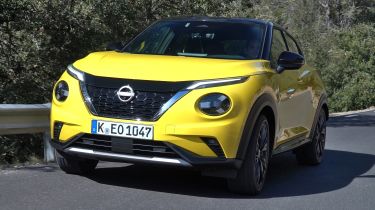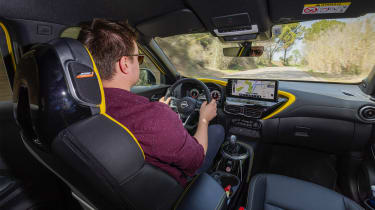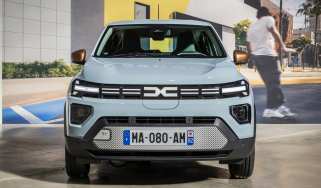Nissan Juke N-Sport hybrid review: welcome changes inside, but dull to drive
The Nissan Juke has been updated for 2024 with a host of interior upgrades, however the driving experience remains unchanged

Verdict
The amendments Nissan has made to the Juke’s interior, in particular the technological upgrades and overall fit and finish, are most welcome. Efficiency remains a strong point too, especially with this hybrid powertrain, and the Juke continues to stand out visually in a tight segment. If you’re not interested in an exciting drive, the Nissan Juke is still a strong contender.
If the Qashqai helped cement Nissan’s status in the booming C-segment SUV genre, the Juke undoubtedly did the same for the firm in the B-segment SUV class. The current, second-generation Juke model arrived in 2017, but still remains an incredibly popular offering, taking eighth spot in the top 10 best-selling cars in the UK in 2023. Hoping to build on this success, Nissan has updated its small SUV for 2024.
Aside from a new selection of alloy wheels and the bold yellow paint, which Nissan says is making a return due to strong demand from “both customers and dealerships”, there’s no difference to be found on the exterior. Nissan says this was a conscious decision, given that the Juke’s style is already “the number one purchase reason for customers”.
The bulk of the changes for 2024 have arrived in the cabin – which is a good thing, because the interior and its quality were far from the best in class. The first things you notice are the new 12.3-inch screens - the same size you get in the much larger Qashqai and Ariya SUVs. The central touchscreen is angled eight degrees towards the driver and this, along with the ‘boomerang’ sweep of Alcantara and the new asymmetric armest, creates a more cocooning environment for the driver.
Used - available now
The infotainment on the touchscreen is new too, and it benefits from a much higher resolution than the old eight-inch unit. It’s a clear and intuitive layout, and we found it to be pretty responsive as well. A few helpful features have been added, such as fuel prices within the integrated sat-nav, improved voice recognition, video playback while stationary and for the driver, a choice of ‘Classic’ or ‘Enhanced’ instrument clusters (although there’s very little difference between the two). The air vents have also been repositioned and there’s a new wireless charging pad for smartphones.
Overall the general quality seems to now be at an acceptable level in the Juke, although our range-topping N-Sport version had flashes of faux carbon fibre around the dash, engine start button and centre-console cupholders, which brought the tone down slightly. That Alcantara trim situated around the cabin can only be swapped with grey, black or silver, so don’t go thinking you can match all of the Juke’s exterior paints.
On the move the Juke Hybrid is pretty much unchanged from before. A 1.6-litre, four-cylinder petrol engine is mated to an electric motor for power outputs of 93bhp and 48bhp respectively, delivering a total system output of 141bhp. That might sound like a decent number, but the multi-modal gearbox lets the side down, often feeling like it's in the wrong gear or not quick enough to match the engine’s speed. In a few circumstances we felt like we were driving a CVT, such was the disconnect from the gearbox – and it happens in Eco, Standard or Sport driving modes. The steering is a plus point, however, with a well-judged weight to it.
Dynamic driving isn’t what the Juke is about (which is good because the Ford Puma easily surpasses it in this sense). Take it steady with the throttle and the hybrid system is smooth to take over power demands, although it’s noticeable, at any speed, when the slightly gruff petrol unit kicks in.
The Juke Hybrid seems at its best when running solely on its tiny 1.2kWh battery, which is a shame, because you only get around 1.5 miles of running at speeds no higher than 31mph. Still, that’s more electric range than you can expect from a Toyota Yaris Hybrid. Economy isn’t quite up to the standard of that car, but it’s still among the best in its class. Efficiency has increased to 58.9mpg with this update (55.6mpg before), although this figure is only achieved on models with 17-inch wheels and their low-resistance eco-tyres. Our test route of city driving and mountainous roads wasn’t indicative of most people’s drives, so we only managed an mpg figure in the mid thirties.
The Juke’s ride continues to be a little firm (although our car was fitted with 19-inch wheels - 17 and 18-inch rims are available), but the redesigned seats are pleasant enough on a long journey. In the rear, most adults will be comfortable, thanks to a low window line letting in plenty of light, and a decent amount of headroom.
Unfortunately, the 2024 updates for the Juke have been met with a price increase, but only £900 across the range - which doesn’t seem too bad, considering the sensible improvements made. The Juke Hybrid kicks off at £23,485 in base-level Acenta Premium and crucially gets the same 12.3-inch screen layout as the top model we tried - the £28,385 N-Sport. It might make more sense to go for the cheaper-to-buy, non-hybrid three-cylinder offerings and take a hit of around 10mpg in efficiency, depending on your annual mileage.
This is most likely the last internal-combustion engined Juke before an all-electric version is launched around 2028. From what we’ve seen it should remain a competitive offering for the rest of its lifespan.
| Model: | Nissan Juke Hybrid |
| Price from: | £23,485 |
| Price as tested: | £31,985 |
| Powertrain: | 1.6-litre, four-cylinder petrol + electric motor |
| Transmission: | Seven-speed automatic, front-wheel drive |
| Power: | 141bhp |
| 0-62mph: | 10.1 seconds |
| Top speed: | 103 mph |
| Economy/CO2: | 58.9mpg/109g/km |
| Size (L/W/H): | 4210mm/1983mm/1593mm |
| On sale: | Now |









